Hyundai Creta 2018 Repair Manual
Manufacturer: HYUNDAI, Model Year: 2018, Model line: Creta, Model: Hyundai Creta 2018Pages: 472, PDF Size: 11.87 MB
Page 61 of 472
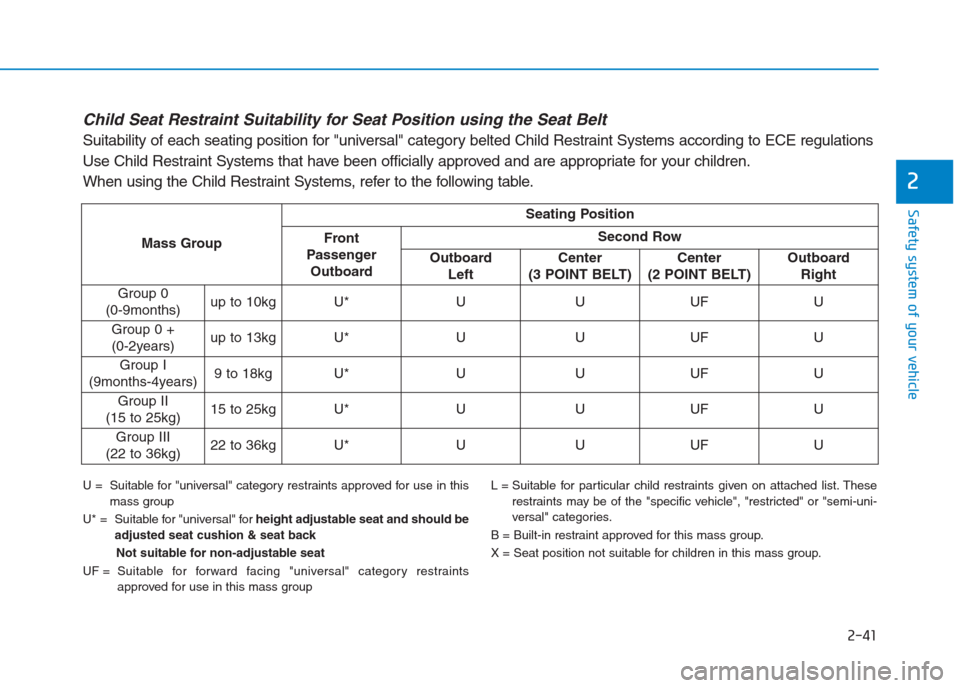
2-41
Safety system of your vehicle
2
Child Seat Restraint Suitability for Seat Position using the Seat Belt
Suitability of each seating position for "universal" category belted Child Restraint Systems according to ECE regulations
Use Child Restraint Systems that have been officially approved and are appropriate for your children.
When using the Child Restraint Systems, refer to the following table.
U = Suitable for "universal" category restraints approved for use in this
mass group
U* = Suitable for "universal" forheight adjustable seat and should be
adjusted seat cushion & seat back
Not suitable for non-adjustable seat
UF = Suitable for forward facing "universal" category restraints
approved for use in this mass groupL = Suitable for particular child restraints given on attached list. These
restraints may be of the "specific vehicle", "restricted" or "semi-uni-
versal" categories.
B = Built-in restraint approved for this mass group.
X = Seat position not suitable for children in this mass group.
Mass Group
Seating Position
Front
Passenger
OutboardSecond Row
Outboard
LeftCenter
(3 POINT BELT)Center
(2 POINT BELT)Outboard
Right
Group 0
(0-9months)up to 10kgU*UUUFU
Group 0 +
(0-2years)up to 13kgU*UUUFU
Group I
(9months-4years)9 to 18kgU*UUUFU
Group II
(15 to 25kg)15 to 25kgU*UUUFU
Group III
(22 to 36kg)22 to 36kgU*UUUFU
Page 62 of 472
![Hyundai Creta 2018 Repair Manual 2-42
Safety system of your vehicle
Child restraint System - EU Approval No.
MakerModel NameGroupApproval No
Britax (or Römer)Duo Plus (with Top Tether)Group 1 [9 ~ 18kg]E1 04301133
Baby-Safe Plus II Hyundai Creta 2018 Repair Manual 2-42
Safety system of your vehicle
Child restraint System - EU Approval No.
MakerModel NameGroupApproval No
Britax (or Römer)Duo Plus (with Top Tether)Group 1 [9 ~ 18kg]E1 04301133
Baby-Safe Plus II](/img/35/14530/w960_14530-61.png)
2-42
Safety system of your vehicle
Child restraint System - EU Approval No.
MakerModel NameGroupApproval No
Britax (or Römer)Duo Plus (with Top Tether)Group 1 [9 ~ 18kg]E1 04301133
Baby-Safe Plus II with ISOFIX AdapterGroup 0+ [0 ~ 13kg]E1 04301146
Page 63 of 472
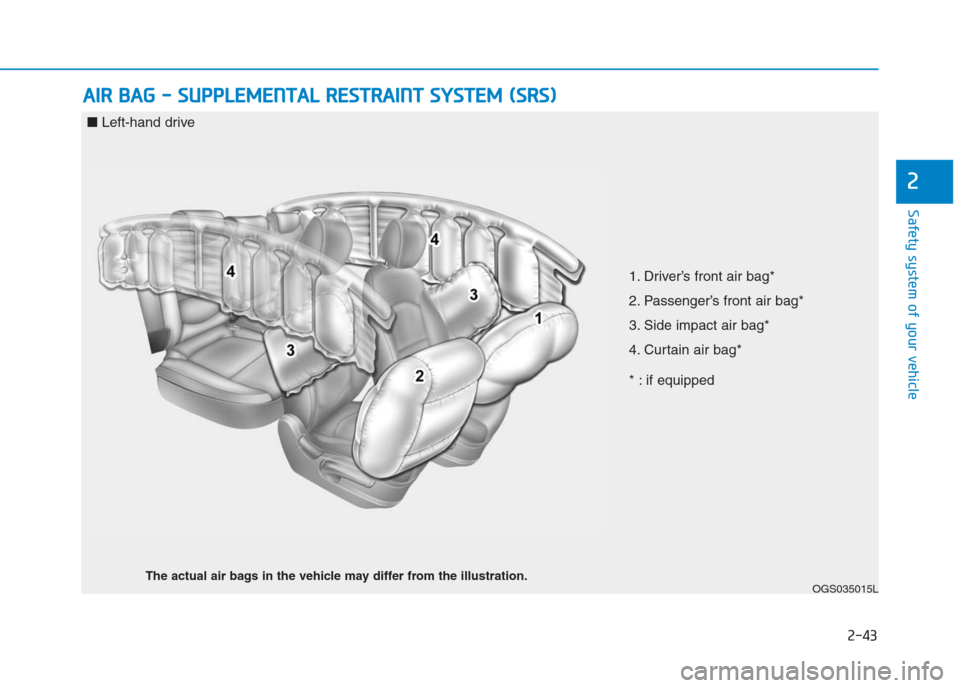
2-43
Safety system of your vehicle
2
A AI
IR
R
B
BA
AG
G
-
-
S
SU
UP
PP
PL
LE
EM
ME
EN
NT
TA
AL
L
R
RE
ES
ST
TR
RA
AI
IN
NT
T
S
SY
YS
ST
TE
EM
M
(
(S
SR
RS
S)
)
OGS035015L
1. Driver’s front air bag*
2. Passenger’s front air bag*
3. Side impact air bag*
4. Curtain air bag*
* : if equipped
■Left-hand drive
The actual air bags in the vehicle may differ from the illustration.
Page 64 of 472
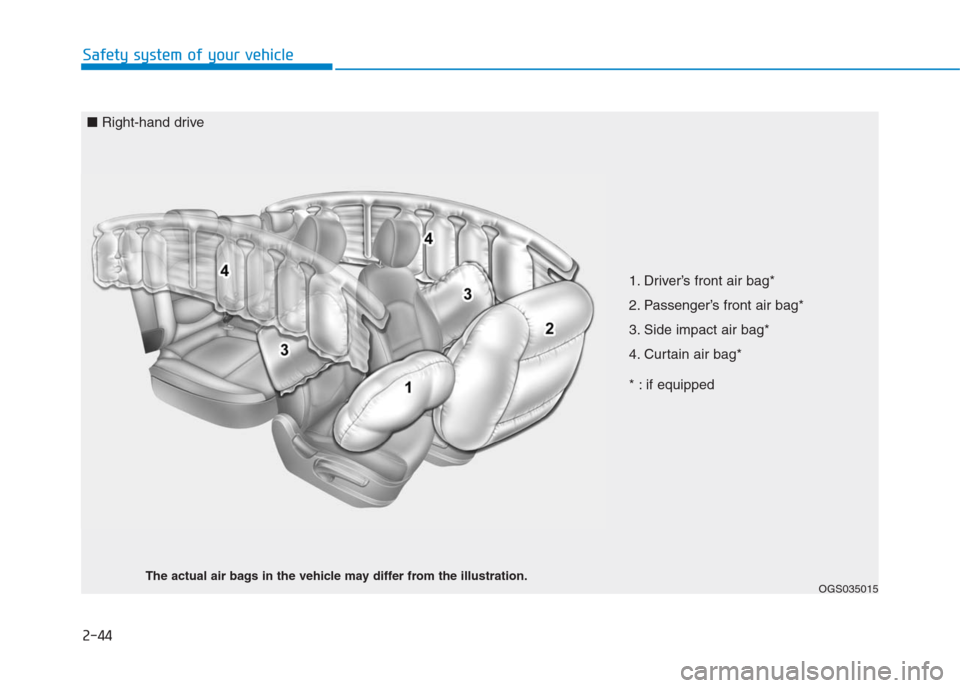
2-44
Safety system of your vehicle
OGS035015
■Right-hand drive
1. Driver’s front air bag*
2. Passenger’s front air bag*
3. Side impact air bag*
4. Curtain air bag*
* : if equipped
The actual air bags in the vehicle may differ from the illustration.
Page 65 of 472
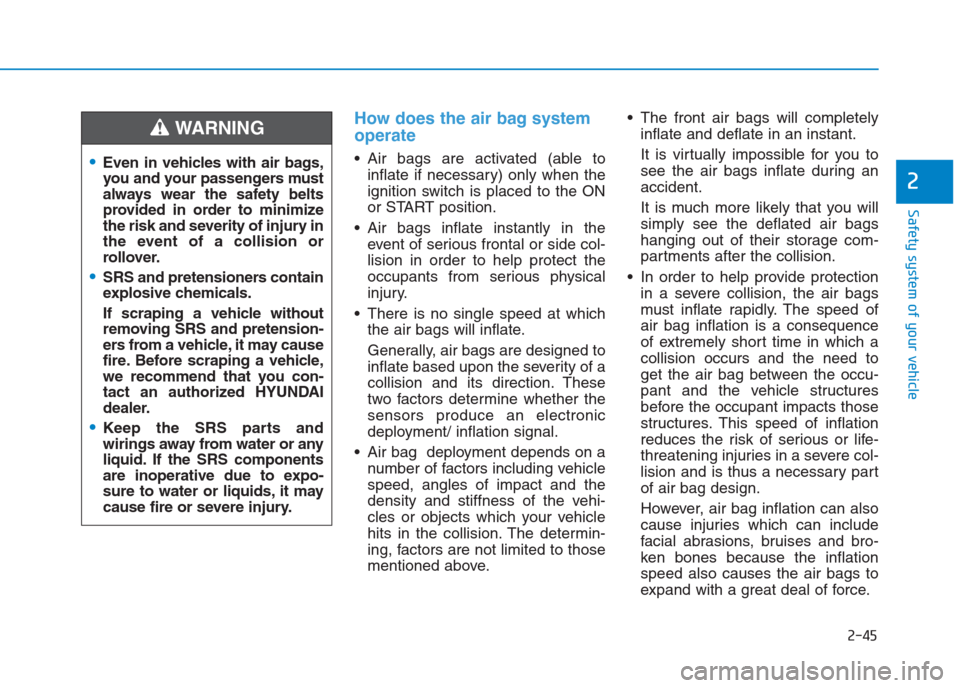
2-45
Safety system of your vehicle
2
How does the air bag system
operate
Air bags are activated (able to
inflate if necessary) only when the
ignition switch is placed to the ON
or START position.
Air bags inflate instantly in the
event of serious frontal or side col-
lision in order to help protect the
occupants from serious physical
injury.
There is no single speed at which
the air bags will inflate.
Generally, air bags are designed to
inflate based upon the severity of a
collision and its direction. These
two factors determine whether the
sensors produce an electronic
deployment/ inflation signal.
Air bag deployment depends on a
number of factors including vehicle
speed, angles of impact and the
density and stiffness of the vehi-
cles or objects which your vehicle
hits in the collision. The determin-
ing, factors are not limited to those
mentioned above. The front air bags will completely
inflate and deflate in an instant.
It is virtually impossible for you to
see the air bags inflate during an
accident.
It is much more likely that you will
simply see the deflated air bags
hanging out of their storage com-
partments after the collision.
In order to help provide protection
in a severe collision, the air bags
must inflate rapidly. The speed of
air bag inflation is a consequence
of extremely short time in which a
collision occurs and the need to
get the air bag between the occu-
pant and the vehicle structures
before the occupant impacts those
structures. This speed of inflation
reduces the risk of serious or life-
threatening injuries in a severe col-
lision and is thus a necessary part
of air bag design.
However, air bag inflation can also
cause injuries which can include
facial abrasions, bruises and bro-
ken bones because the inflation
speed also causes the air bags to
expand with a great deal of force.Even in vehicles with air bags,
you and your passengers must
always wear the safety belts
provided in order to minimize
the risk and severity of injury in
the event of a collision or
rollover.
SRS and pretensioners contain
explosive chemicals.
If scraping a vehicle without
removing SRS and pretension-
ers from a vehicle, it may cause
fire. Before scraping a vehicle,
we recommend that you con-
tact an authorized HYUNDAI
dealer.
Keep the SRS parts and
wirings away from water or any
liquid. If the SRS components
are inoperative due to expo-
sure to water or liquids, it may
cause fire or severe injury.
WARNING
Page 66 of 472
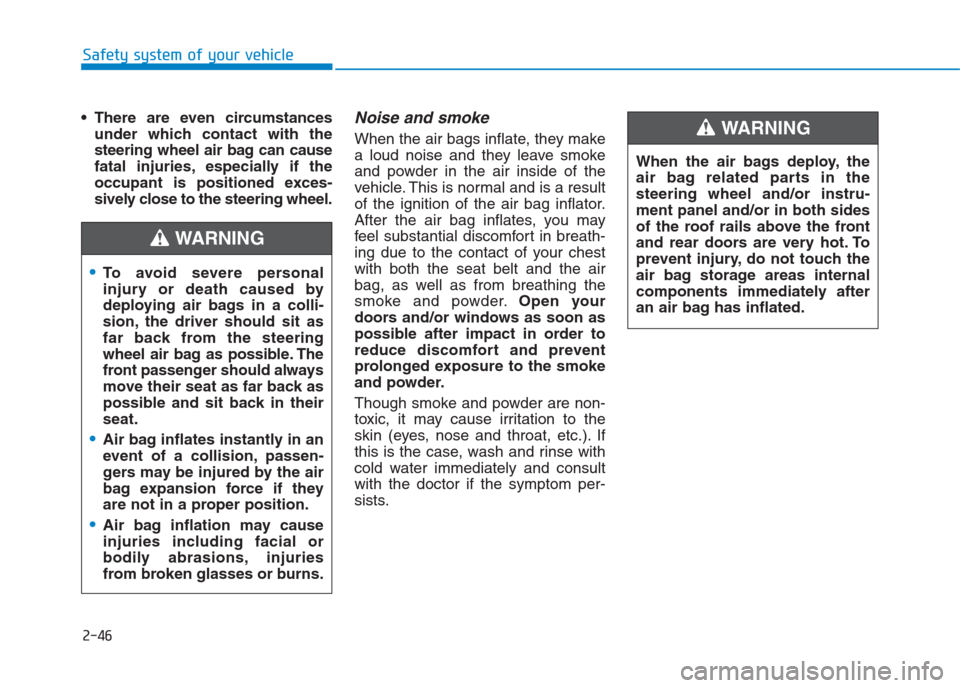
2-46
Safety system of your vehicle
There are even circumstances
under which contact with the
steering wheel air bag can cause
fatal injuries, especially if the
occupant is positioned exces-
sively close to the steering wheel.
Noise and smoke
When the air bags inflate, they make
a loud noise and they leave smoke
and powder in the air inside of the
vehicle. This is normal and is a result
of the ignition of the air bag inflator.
After the air bag inflates, you may
feel substantial discomfort in breath-
ing due to the contact of your chest
with both the seat belt and the air
bag, as well as from breathing the
smoke and powder.Open your
doors and/or windows as soon as
possible after impact in order to
reduce discomfort and prevent
prolonged exposure to the smoke
and powder.
Though smoke and powder are non-
toxic, it may cause irritation to the
skin (eyes, nose and throat, etc.). If
this is the case, wash and rinse with
cold water immediately and consult
with the doctor if the symptom per-
sists.
To avoid severe personal
injury or death caused by
deploying air bags in a colli-
sion, the driver should sit as
far back from the steering
wheel air bag as possible. The
front passenger should always
move their seat as far back as
possible and sit back in their
seat.
Air bag inflates instantly in an
event of a collision, passen-
gers may be injured by the air
bag expansion force if they
are not in a proper position.
Air bag inflation may cause
injuries including facial or
bodily abrasions, injuries
from broken glasses or burns.
When the air bags deploy, the
air bag related parts in the
steering wheel and/or instru-
ment panel and/or in both sides
of the roof rails above the front
and rear doors are very hot. To
prevent injury, do not touch the
air bag storage areas internal
components immediately after
an air bag has inflated.
WARNING
WARNING
Page 67 of 472
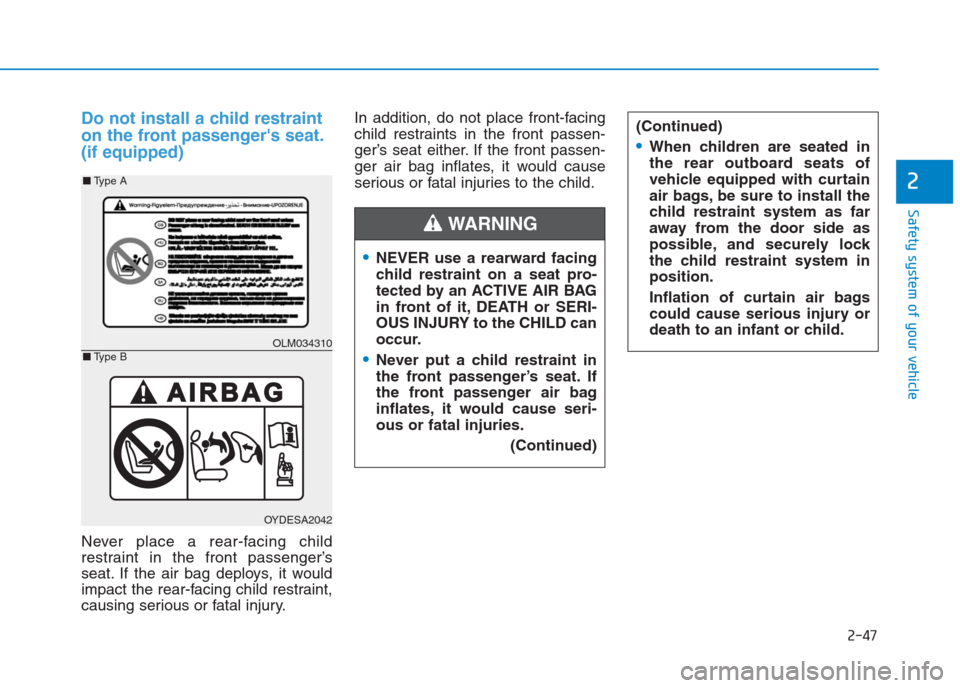
2-47
Safety system of your vehicle
2
Do not install a child restraint
on the front passenger's seat.
(if equipped)
Never place a rear-facing child
restraint in the front passenger’s
seat. If the air bag deploys, it would
impact the rear-facing child restraint,
causing serious or fatal injury.In addition, do not place front-facing
child restraints in the front passen-
ger’s seat either. If the front passen-
ger air bag inflates, it would cause
serious or fatal injuries to the child.
OLM034310
OYDESA2042
■Type A
■Type B
NEVER use a rearward facing
child restraint on a seat pro-
tected by an ACTIVE AIR BAG
in front of it, DEATH or SERI-
OUS INJURY to the CHILD can
occur.
Never put a child restraint in
the front passenger’s seat. If
the front passenger air bag
inflates, it would cause seri-
ous or fatal injuries.
(Continued)
WARNING
(Continued)
When children are seated in
the rear outboard seats of
vehicle equipped with curtain
air bags, be sure to install the
child restraint system as far
away from the door side as
possible, and securely lock
the child restraint system in
position.
Inflation of curtain air bags
could cause serious injury or
death to an infant or child.
Page 68 of 472
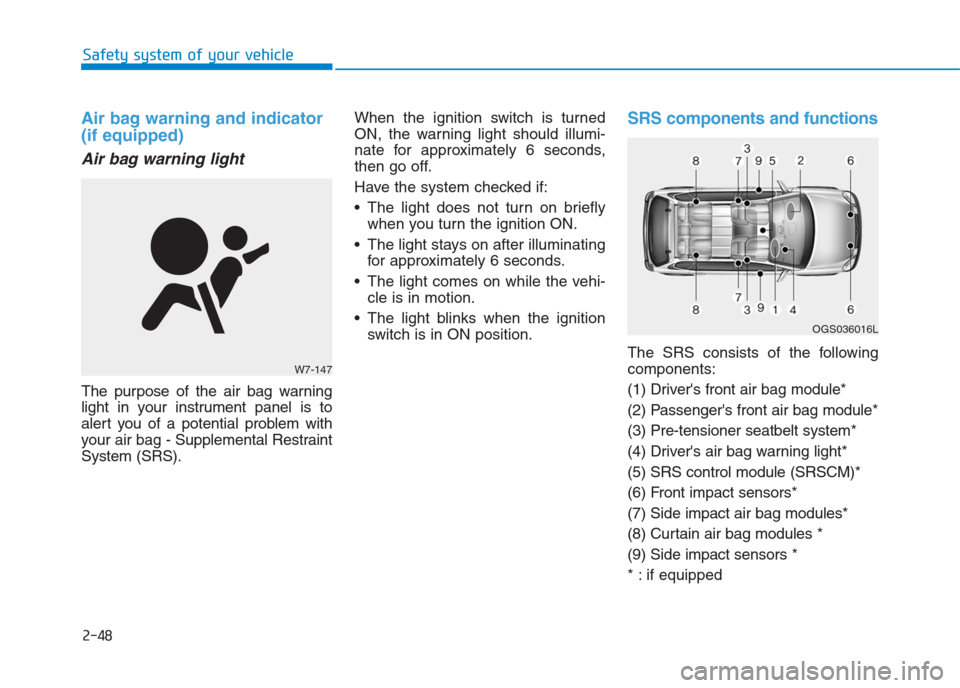
2-48
Safety system of your vehicle
Air bag warning and indicator
(if equipped)
Air bag warning light
The purpose of the air bag warning
light in your instrument panel is to
alert you of a potential problem with
your air bag - Supplemental Restraint
System (SRS).When the ignition switch is turned
ON, the warning light should illumi-
nate for approximately 6 seconds,
then go off.
Have the system checked if:
The light does not turn on briefly
when you turn the ignition ON.
The light stays on after illuminating
for approximately 6 seconds.
The light comes on while the vehi-
cle is in motion.
The light blinks when the ignition
switch is in ON position.
SRS components and functions
The SRS consists of the following
components:
(1) Driver's front air bag module*
(2) Passenger's front air bag module*
(3) Pre-tensioner seatbelt system*
(4) Driver's air bag warning light*
(5) SRS control module (SRSCM)*
(6) Front impact sensors*
(7) Side impact air bag modules*
(8) Curtain air bag modules *
(9) Side impact sensors *
* : if equipped
W7-147
OGS036016L
Page 69 of 472
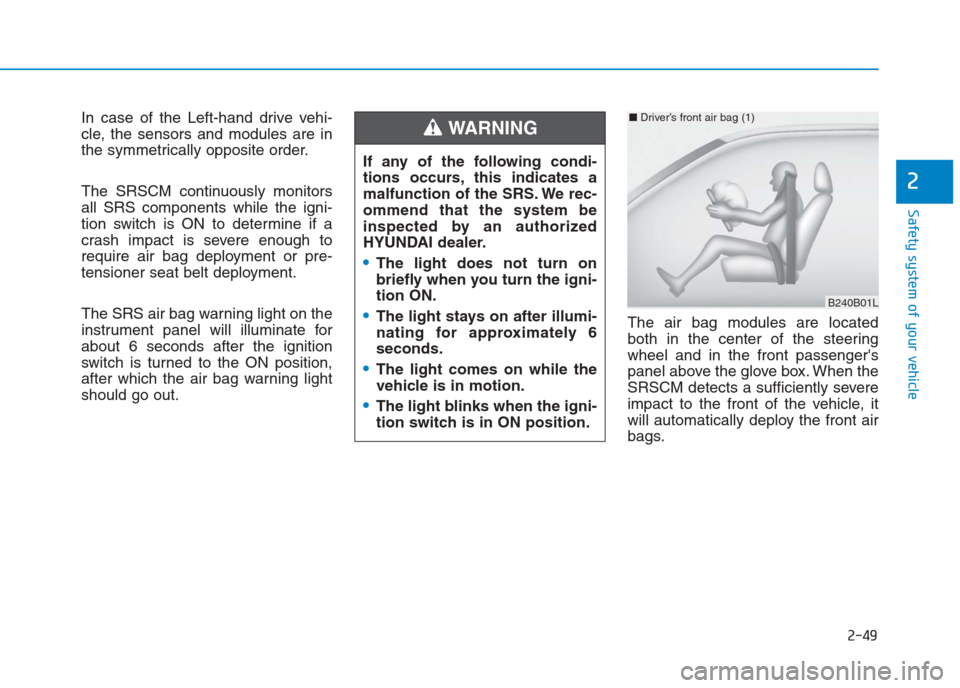
2-49
Safety system of your vehicle
2
In case of the Left-hand drive vehi-
cle, the sensors and modules are in
the symmetrically opposite order.
The SRSCM continuously monitors
all SRS components while the igni-
tion switch is ON to determine if a
crash impact is severe enough to
require air bag deployment or pre-
tensioner seat belt deployment.
The SRS air bag warning light on the
instrument panel will illuminate for
about 6 seconds after the ignition
switch is turned to the ON position,
after which the air bag warning light
should go out.The air bag modules are located
both in the center of the steering
wheel and in the front passenger's
panel above the glove box. When the
SRSCM detects a sufficiently severe
impact to the front of the vehicle, it
will automatically deploy the front air
bags. If any of the following condi-
tions occurs, this indicates a
malfunction of the SRS. We rec-
ommend that the system be
inspected by an authorized
HYUNDAI dealer.
The light does not turn on
briefly when you turn the igni-
tion ON.
The light stays on after illumi-
nating for approximately 6
seconds.
The light comes on while the
vehicle is in motion.
The light blinks when the igni-
tion switch is in ON position.
WARNING
B240B01L
■Driver’s front air bag (1)
Page 70 of 472
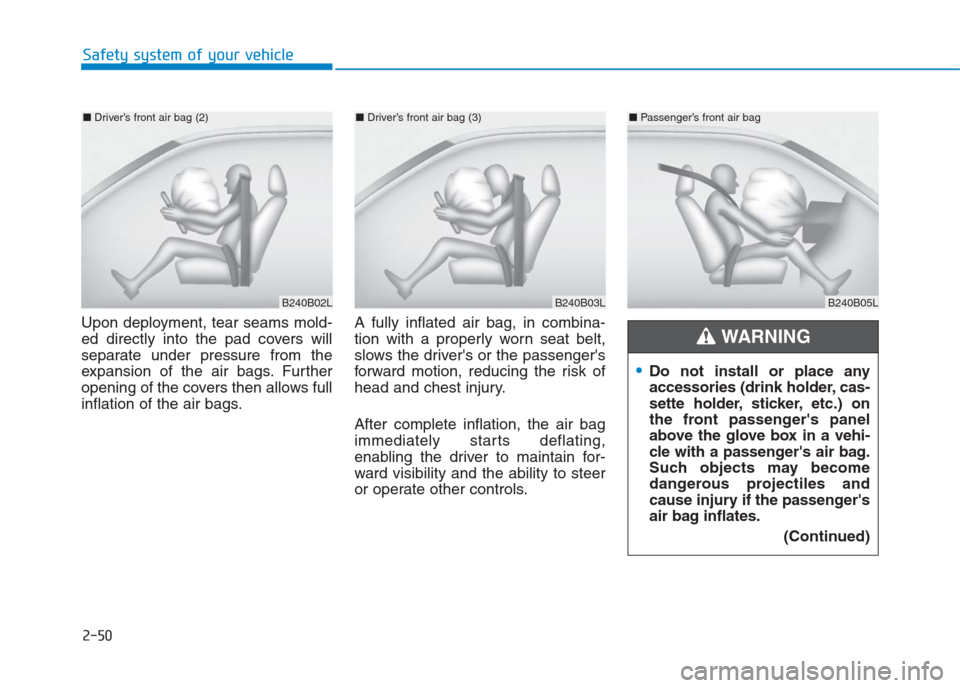
2-50
Safety system of your vehicle
Upon deployment, tear seams mold-
ed directly into the pad covers will
separate under pressure from the
expansion of the air bags. Further
opening of the covers then allows full
inflation of the air bags.A fully inflated air bag, in combina-
tion with a properly worn seat belt,
slows the driver's or the passenger's
forward motion, reducing the risk of
head and chest injury.
After complete inflation, the air bag
immediately starts deflating,
enabling the driver to maintain for-
ward visibility and the ability to steer
or operate other controls.
B240B05L
■ Passenger’s front air bag
B240B03L
■Driver’s front air bag (3)
Do not install or place any
accessories (drink holder, cas-
sette holder, sticker, etc.) on
the front passenger's panel
above the glove box in a vehi-
cle with a passenger's air bag.
Such objects may become
dangerous projectiles and
cause injury if the passenger's
air bag inflates.
(Continued)
WARNING
B240B02L
■Driver’s front air bag (2)